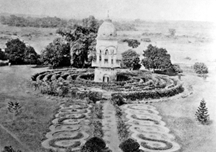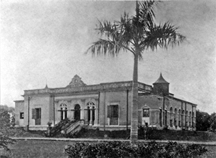Dilkusha
Dilkusha an are adjacent to the present Bangabhaban in Dhaka. It is now a commercial place. The area was once adorned with a Rang Mahal built by Mirza Mohammad. A big canal, later on turned into a lake and known as Motijheel, used to run through it. With the passage of time, the whole area came to be known by that name. Mir Mukim, the Daroga of Mir Jumla's naval force, had his residence in the area to the west of the Bangabhaban.

In 1866, Nawab abdul ghani purchased the land in the western part of the garden from one E F Smith and made a splendid garden-house there for his elder son, khwaja ahsanullah. It was named Dilkhusha (heart pleasing).
In 1877, Nawab Ahshanullah extended it on the north by taking lease of 15 bighas of land from the Dhaka Municipality. It may be mentioned here that at the same time he built company bagan, a park at Paltan, by taking lease of 80 bighas of land from the government.
The Dilkusha garden-house was fortified with a wall round it. The most attractive residence in the area was a red coloured palace. Nawab Ahshanullah spent a large part of his life in this grand palace. In 1888 he and his family members had to stay here for about three years because ahsan manzil was badly damaged by a terrible tornado.
Subsequently, he presented the palace to his daughter Maher Banu and his son-in-law Khan Bahadur Md. Azam, who dwelt there. In 1873 Nawab Ahshanullah had a large pond dug on the southern side of the garden-house, which was known as Dana Dighi.

An exquisite room for relaxation, Hawakhana, was built on the brick-built ghat of the pond. ‘Manuk House’, a large and gorgeous palace was built at a distance from it. The Dilkusha Garden was decorated with a serpentine lake, various kinds of fountains, square water tanks with fishes of different colours, various species of indigenous and exotic trees, and fruit and flower plants. An exquisite tower ‘Bulbulaiya’ was the central attraction in the palace premises. A pretty bungalow was constructed on an artificial hill (120 feet high) in the area. On the northern part of the garden, Baraduari, was a drawing room, open on all sides and adorned with marble floors. Near it and in the middle of a garden was an octagonal marble kiosk.
In the artificial lake located near the entrance a number of crocodiles were kept. Next to it was a playground. Besides playing there, the members of the nawab family used to arrange kite-flying competitions in the winter. Later on, a number of one-storeyed buildings were constructed in the vicinity of the northern boundary wall of Dilkusha Garden.
The Dilkusha area was famous for two illustrious saints. The mosque of 'Dakhini Shahib', located in the rajuk premises, was on the northern side of the western entrance of Dilkusha Garden. Beside the grave of Shah Niamatullah in the yard of the mosque are the graves of the nawab's daughters Meher Banu and Shawkat Ara Banu, General Wasiuddin and others. shahjalal dakhini was buried in the single-domed structure within the Bangabhaban area.
When Dhaka became the capital of East Bengal and Assam in 1905, the government took lease of the southern portion of Dilkusha Garden in order to build government offices. The northern portion remained under the possession of the nawabs. A road separated the two sides. After the abolition of zamindari in 1951, the nawab's garden house started to decay due to lack of maintenance. In the late fifties, the government and the DIT authority acquired the remaining part of the garden.

Many significant incidents of social, cultural, and political history of this region took place at the Dilkusha Garden House. In 1885 an Italian pundit came to Dhaka to observe the standard and condition of Sanskrit studies in this country. Nawab Abdul Ghani arranged a conference of the pundits of this country at Dilkusha Garden House on 3rd February 1885. On 21st August 1888 Nawab Ahshanullah gave a grand reception in this garden to Lt. Governor Sir Stuart Bailey, when he came to visit Dhaka. In 1891 an agricultural and industrial fair, like the one held at Shahbag, was arranged at the Dilkusha Garden on the occasion of the Christian New Year.
On 22 July 1902, a discussion between nawab salilmullah and Governor Woodburn took place in this Garden when the governor was on a visit to Dhaka. On 18 January 1906, the wife of fuller, the newly appointed Governor of East Bengal and Assam, arranged a reception at Dilkusha Garden in honour of the notable persons of the province.
On 20 July 1914, Governor lord carmichael and his wife were accorded a grand reception here. On 13 February 1924 Major Suhrawardy, Deputy President of the Bengal Executive Council, was accorded a reception here. In 1948 huseyn shaheed suhrawardy and maulana abdul hamid khan bhasani sat together in a political discussion here in the house of Khwaja Nasrullah. [Mohammad Alamgir]
Bibliography Dhaka Prakash, 1874, 1885, 1888, 1891, 1902, 1924; RA taesh, Tawarikhey Dhaka, (translated in to Bangla by AMM Sharfuddin), Dhaka,1985; HH Rahman, Asudganey Dhaka, (translated in to Bangla by Moulana Akram Faruque and Ruhul Amin Choudhury), Dhaka, 1990; Old files and documents preserved at Ahsan Manzil Museum and Nawab State's Office; Personal Diary (Urdu) of Nawab Ahshanullah preserved at Ahsan Manzil; AH Dani, Dacca- A Record of its Changing Fortunes, 1962.
